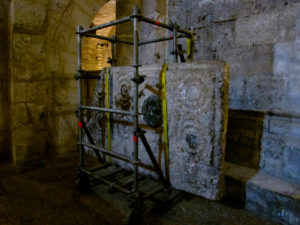Excavations uncover church’s original medieval altar
Nathan Steinmeyer April 22, 2022 0 Comments 732 views
During building renovations in Jerusalem’s Church of the Holy Sepulchre, archaeologists came across a stunning discovery, a large section from the church’s original ancient altar. The excavators believe that the stone slab, which measures about 8 by 5 feet, once adorned the 12th-century high altar from one of Christianity’s holiest sites. For hundreds of years, the high priests of the church would have given the liturgy from behind this very stone.


As first reported by Reuters, the ancient altar was discovered in a back corridor of the Holy Sepulchre, where it was likely placed following a large fire in 1808. As its ornately decorated face was hidden against the wall, the slab sat in the corridor for more than 200 years, collecting graffiti from pilgrims and tourists who had no clue what they were writing on. Archaeologists believe the ancient altar is the same one described by pilgrims during the church’s consecration in 1149. The altar was first used by Catholic priests, who controlled the site until the departure of the Crusaders, and then by the Greek Orthodox, who used it continuously until the fire of 1808.
The ancient altar was designed in the “cosmatesque” style, which reflects a combination of classical, Byzantine, and early Islamic traditions. Although the slab has suffered greatly over the years, it originally featured finely worked and colorful marble tiles with detailed engravings. “You cannot see it now, but originally it was inlaid with pieces of precious marble, pieces of glass, pieces of small, finely made marble,” said Amit Re’em, Jerusalem regional archaeologist for the Israel Antiquities Authority, in an interview with Reuters. “It was shining, and this was a really amazing artifact.” Similar decorated altars have been found in churches in Rome, dating to the 12th and 13th centuries.
[embedded content]
The ancient altar was discovered during renovations of the Church of the Holy Sepulchre, in which the floors of many sections of the church are being repaired and replaced. These renovations have allowed for the first modern archaeological excavation of the ancient church and promise to provide a plethora of incredible finds like this ancient altar. Renovations began in the Chapel of St. Helena, one of the oldest sections of the church, in 2018 and have resumed in 2022 following two years of pandemic-related lockdowns and restrictions.
Read more in Bible History Daily:
All-Access members, read more in the BAS Library:
Does the Holy Sepulchre Church Mark the Burial of Jesus?
The Evolution of a Church—Jerusalem’s Holy Sepulchre
Evidence of Earliest Christian Pilgrimage to the Holy Land Comes to Light in Holy Sepulchre Church
Not a BAS Library or All-Access Member yet? Join today.


